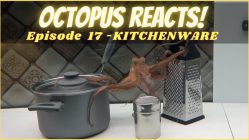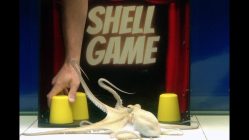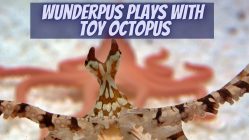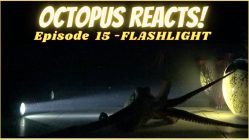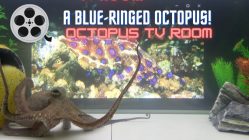
For centuries, biologists maintained that only human beings were capable of making tools. After all, this is what gave us the advantage needed to become the dominant species on the planet.
With time it was learned that other species also use rudimentary tools. Chimps using sticks to “fish” for termites, for example. However, these were viewed as crude examples. These were single-purpose tools that didn’t involve much creativity and did not involve much in terms of gathering and preparation.
Then, observational studies of a specific species of octopus turned all prior theories regarding tool building by animals on their head.
What octopus are we talking about? The Amphioctopus marginatus — more commonly known as the coconut octopus.
Before we cover some of the more amazing facts about the Amphioctopus marginatus’ behavior, let’s take a look at some of the basic attributes of this species.
Coconut Octopus Facts
- Scientific Name : Amphioctopus Marginatus
- Common Name: Coconut Octopus, Veined Octopus
- Size: average 6 inches
- Weight: 10 ounces (300 grams)
- Lifespan: 3-5 years
- Found in: Pacific and Indian oceans
- Sub-Order: Incirrina
- Discovered: 1964
- Scientific Name : Amphioctopus Marginatus
- Common Name: Coconut Octopus, Veined Octopus
- Size: average 6 inches
- Weight: 10 ounces (300 grams)
- Lifespan: 3-5 years
- Found in: Pacific and Indian oceans
- Sub-Order: Incirrina
- Discovered: 1964
The coconut octopus has been observed to be a tool maker. That alone is enough to make the species interesting. If you are an octopus enthusiast, the coconut octopus will constantly leave you going, “wow!”
—Habitat and Range of the Coconut Octopus—

The coconut octopus is found in the western Pacific and Indian oceans. It is classified as a tropical water species. It can be found off the coast of southern Japan as well as Australia, New Guinea, and South Africa.
It prefers shallow coastal waters and spends the majority of its time on the sandy or muddy seafloor close to the shoreline. This species also shows a preference for calmer waters as opposed to the swifter seas of the open ocean. This is why it is frequently found in bays, lagoons, and other inlets.
No evidence of the coconut octopus occupying deeper waters has ever been found. The deepest water that the coconut octopus calls home is 600 feet with most specimens living at far shallower depths.
Size
The coconut octopus is on the smaller end of the spectrum in terms of body size. From head to the tips of its arms, it rarely surpasses six inches in length. Measuring the head alone, it is approximately three inches in length.
Being a soft-tissued creature, the full bodyweight of an adult coconut octopus rarely reaches ten ounces.
Appearance

Like the majority of octopus species, the coconut octopus can change the color of its skin to match the color and texture details of its immediate surroundings. When not engaged in a camouflaged pose, the coconut octopus displays a dark brownish to orange color. The color distribution is marked by darker ramified lines which take on a vein-like pattern.
The skin color on the outer portion of the arm along the edges also tends to be darker. The siphon, the tube-like structure on its head which the creature uses to draw water into its gills and expel it for fast sprints, is usually lighter in color. It is a yellowish shade.
One of the most distinctive features of the coconut octopus is its suckers. They are almost white and really stick out when the creature has assumed a darker color. The contrast in colors between its body and its suckers can create a fluorescent effect for the suckers. It is important to note that such an effect is purely visual. The coconut octopus does not produce any form of bioluminescence. In other words, it is just a matter of sharp color contrast, the coconut octopus does not really glow.
Diet
The coconut octopus feeds on crabs, clams, and shrimp. It uses a hybrid style of catching prey. It incorporates active predatory techniques as well as passive methods for reaching its prey.
Hunting Styles of the Coconut Octopus

In the predatory style, it will seek out prey and position itself to pounce on the prey. In doing so, it grabs the other creature with its arms and brings it to its mouth as fast as possible. This is done in order to pierce the prey with its beak. The beak of the coconut octopus is the only rigid part of its body. It is very strong and can puncture or rip through the exoskeleton of arthropods, such as crabs and shrimp, while also being able to pry open the shells of clams.
Some marine biologists describe the active style of hunting that the coconut octopus engages in as foraging. This due to the fact that the coconut octopus appears to wander about when it is hunting until it encounters suitable prey or they encounter it. In other words, this octopus does not stalk prey.
Dusk and dawn are the preferred hours for active hunting on the part of the coconut octopus.
When the coconut octopus is in a passive hunting mode it will usually be in its den or improvised field shelter. It can also be burrowed in the sand or mud of the seafloor with only its eyes sticking out.
During those moments, the coconut octopus will emerge suddenly and catch unsuspecting prey by surprise if they come within easy reach. This style of passive hunting can take place at any time of the day or night
Life Span

The coconut octopus has one of the longer life spans for small-sized octopuses. They normally live for three to five years.
The primary contributing factor to determining their life span is when they decide to mate. The coconut octopus reaches sexual maturity between 18 and 24 months of age.
Once a male mates he will die soon thereafter. This takes place within weeks — sometimes days.
The female can continue living for months or years. She will die only after she has laid her eggs and they have hatched.
Mating Style of the Coconut Octopus

The mating ritual of the coconut octopus employs a “the faster the better” approach. Males prefer to insert their sperm packet with their specialized “sex arm” into the mantle of the female as quickly as possible. This to avoid having their seven free arms from becoming entangled with the female.
When a male and female coconut octopus do become involved in a more complex mating dance, it has been observed in the wild that the females often strangle the male and then eat him. That’s definitely not the sort of dinner date that you ever want to have.
To avoid being eaten, male coconut octopuses employ the “mate and dash” technique. Some also disguise themselves as females in order to stand a chance while approaching.
Since the mating style of the coconut octopus is designed to be as fast and as distant as possible, there have been observations of a female octopus “entertaining” two or more male suitors at once. Yes, a coconut octopus underwater orgy, so to speak.
Since the female carries the sperm packets in her mantle until she is ready to lay her eggs, having sperm packets from multiple males is not a problem. Consequently, the hatchlings that emerge from a specific brood can have multiple fathers.
A female coconut octopus will normally lay approximately 100,000 eggs. Each egg measures less than one-quarter of an inch in diameter. The female will brood the eggs in a secure location such as a crevice or other shelter. She will guard over them and keep them aerated while also cleaning them with her arms.
—Now for the Interesting Part...—
As was stated above, the coconut octopus has been observed to be a tool maker. That alone is enough to make the species interesting. However, like a skilled showman who wants to deliver more pizzazz to his audience, so too does the coconut octopus deliver more. If you are an octopus enthusiast, the coconut octopus will constantly leave you going, “wow!”
—Bipedalism—

We, as humans, are bipedal. We walk on two legs. That is our primary means of locomotion. In nature, this characteristic is not that common. Most creatures will walk on four legs if they walk at all.
Well, the coconut octopus was up for the challenge. It engages in a form of bipedalism.
You may wonder how a creature that lacks a skeleton, whose body is basically a large head and eight arms, can walk? Especially when this creature lives the entirety of its life underwater.
It is important to understand that the coconut octopus, like all octopuses, is a highly cognitive and intelligent creature. Over the course of millions of years of evolution, octopuses have evolved a standard set of locomotion. Most animals stick with what nature has provided for them. Octopuses, like humans, however, constantly try to improve on nature.
The coconut octopus can funnel water through its siphon to create streams of water that can propel it at high speed in the blink of an eye. This is perfect when the coconut octopus has to flee from danger. It can also swim through the water using its arms to propel itself. This is an energy-efficient way to coast from spot to spot.
It is, however, in the third method of octopus locomotion that the coconut octopus leaves our jaws dropping. You see, nearly all octopus species have the ability to use their arms to walk on the seafloor. This action usually involves using all of their arms. The method is efficient as a strolling action.
The coconut octopus takes its ability to walk with its arms to a whole new level. Not only can it use the method common with other species, but it can also walk on two extended arms alone. This emulates the bipedalism of us humans.
Why Be Bipedal?

The coconut octopus obviously did not develop its bipedal abilities because it was jealous of how humans are able to walk. Its bipedalism is due to an adaptation to its environment.
When a coconut octopus engages in bipedal walking, it does so while carrying a coconut shell on its head. No, they are not modeling hats when they do this. Although some coconut octopuses can look rather stylish doing so.
What they are in fact doing is using the coconut as a form of shield and camouflage. When the coconut shell on their head is combined with the specific motion created by its bipedal walking, it creates the perfect cover.
Seen from above, the coconut shell moving along the ocean floor does not raise suspicion from potential predators of the coconut octopus’ movements. This is because when coconut shells sink to the bottom, they are frequently moved and tossed about by even the gentlest of water currents.
The coconut octopus replicates this natural occurrence and uses it as an effective way to shield its movements.

—Tool Building—

Using coconut shells as a head shield while engaging in bipedal walking can accurately be described as a form of tool usage. After all, it is using the coconut shell as both a helmet and a camouflaging device. The coconut octopus, however, doesn’t stop there.
This species of octopus will actively search for coconut shells and empty clamshells of different sizes. It does so because it is able to recognize that different sized shells have different uses.
Some are useful as the camouflaging helmets that it uses when walking. Others are useful as shields against lateral attacks. And others, when used in tandem, make for excellent building blocks for shelters. These can tale n the form of simple fences to more complex den structures.
The coconut octopus can even crawl into a coconut shell and roll while inside it. A compact underwater vehicle so to speak.
This means that the coconut octopus is selective in the raw materials that it uses for its tools. Imagine yourself at Home Depot on a Saturday afternoon spending hours finding the right tools and the right materials for your weekend project. Coconut octopuses use the same level of care in selecting their materials.
In spite of its common name, the coconut octopus does not limit itself to coconut shells when it comes to tools. They also use clamshells and discarded containers left behind by humans.
To say is that a specific species of octopus is smart is really saying something. This because all of the octopus species are very intelligent. However, it is impossible not to classify the amazing abilities of the coconut octopus on a higher plane. Even though small in size, it is huge in ability and intelligence. It is among the best at problem-solving. As far as invertebrates go, it is likely on top.



